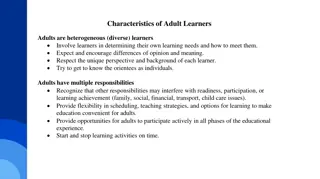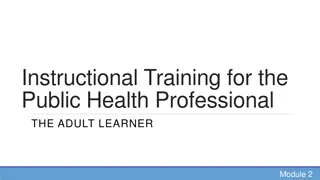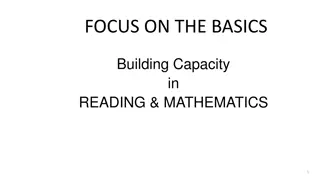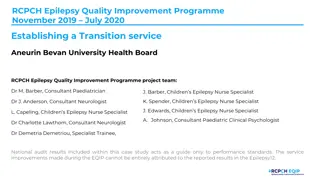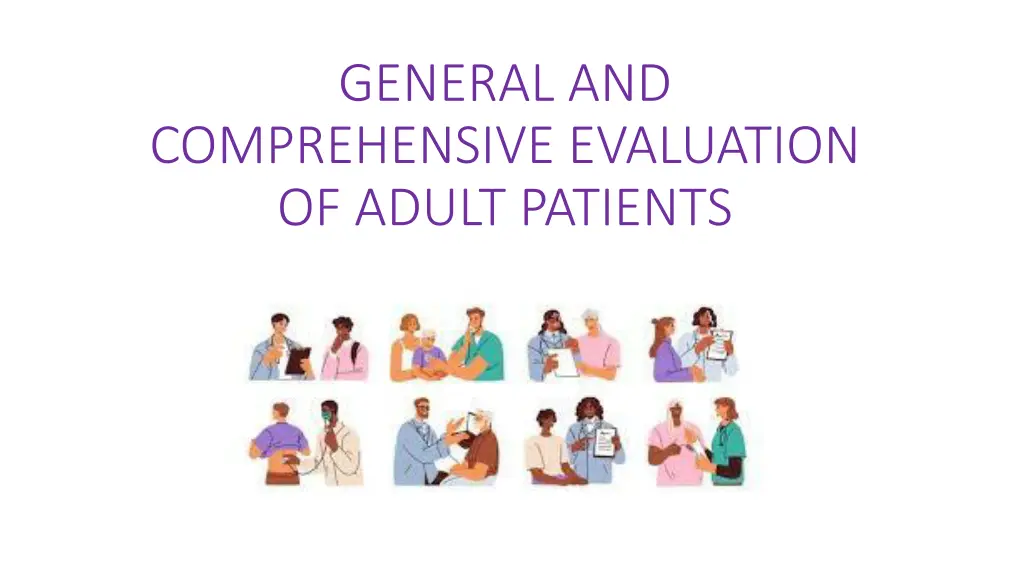
Adult Patient Evaluation and History Overview
Explore the essential components of evaluating and interviewing adult patients, including the patient interview, chief complaint definition, history of present illness (HPI), example scenarios, and past medical history (PMH). Learn about key elements like onset, location, duration, characteristics, aggravating/alleviating factors, associated symptoms, chronic illnesses, surgeries, hospitalizations, immunizations, and screenings.
Download Presentation

Please find below an Image/Link to download the presentation.
The content on the website is provided AS IS for your information and personal use only. It may not be sold, licensed, or shared on other websites without obtaining consent from the author. If you encounter any issues during the download, it is possible that the publisher has removed the file from their server.
You are allowed to download the files provided on this website for personal or commercial use, subject to the condition that they are used lawfully. All files are the property of their respective owners.
The content on the website is provided AS IS for your information and personal use only. It may not be sold, licensed, or shared on other websites without obtaining consent from the author.
E N D
Presentation Transcript
GENERAL AND COMPREHENSIVE EVALUATION OF ADULT PATIENTS
Patient Interview 1. Introduction to Patient Interview The patient interview is a critical component of the general evaluation. It establishes rapport, gathers essential information, and guides clinical decision- making. 2. Chief Complaint Definition: The primary reason for the patient s visit. Example: A patient states, I have been having severe headaches for the past two weeks.
3. History of Present Illness (HPI) The HPI provides a detailed narrative of the patient's current symptoms, focusing on the chief complaint. Key elements include: 3.1. Key Components of HPI Onset: When did the symptoms begin? Location: Where is the symptom located? Duration: How long do the symptoms last? Characteristics: What is the nature of the symptom? Aggravating/Alleviating Factors: What makes it worse or better? Associated Symptoms: Are there other symptoms present?
3.2. Example Scenario Patient Presentation: Chief Complaint: I have been having severe headaches for the past two weeks. HPI Narrative: Onset: The headaches started suddenly two weeks ago while I was at work. Location: They are mostly on the right side of my head, just above my eye. Duration: The pain usually lasts for about 3 to 4 hours and occurs daily. Characteristics: The pain is throbbing and is rated 8 out of 10 on the pain scale. Aggravating Factors: Loud noises and bright lights make it worse. Alleviating Factors: Taking ibuprofen helps reduce the pain somewhat. Associated Symptoms: I also feel nauseous and sometimes see flashes of light in my vision.
Illustration: | Element | Description | | Onset | Sudden, two weeks ago at work | |----------------------|--------------------------------------------------| | Location | Right side of head, above eye | | Duration | 3-4 hours, daily | | Characteristics | Throbbing, 8/10 pain | | Aggravating Factors | Loud noises, bright lights | | Alleviating Factors | Ibuprofen helps slightly | | Associated Symptoms | Nausea, flashes of light in vision |
4. Past Medical History (PMH) The PMH provides insight into the patient's previous health conditions, treatments, and risk factors. 4.1. Key Components of PMH Chronic Illnesses: Any long-term conditions (e.g., diabetes, hypertension). Surgeries: Previous surgeries and outcomes. Hospitalizations: Any significant hospital stays, including dates and reasons. Immunizations: Up-to-date vaccination status. Screenings: Relevant health screenings (e.g., mammograms, colonoscopies).
4.2. Example Scenario Patient Presentation: The patient with a history of headaches undergoes a thorough PMH evaluation. PMH Narrative: Chronic Illnesses: I have high blood pressure, diagnosed three years ago. Surgeries: I had my appendix removed when I was 20 years old. Hospitalizations: I was hospitalized for a week last year due to pneumonia. Immunizations: I received my flu shot last fall; I haven t had a tetanus booster in over 5 years. Screenings: I had a colonoscopy two years ago, which was normal.
Illustration | Component | Details | |-----------------------|--------------------------------------------------| | Chronic Illnesses | Hypertension (diagnosed 3 years ago) | | Surgeries | Appendectomy at age 20 | | Hospitalizations | Pneumonia (last year, hospitalized for 1 week) | | Immunizations | Flu shot last fall, tetanus booster overdue | | Screenings | Colonoscopy two years ago, normal results |
Conclusion The HPI and PMH sections of the patient interview are essential for understanding the context of a patient's current health status. Detailed inquiries can reveal underlying conditions and guide further diagnostic and therapeutic decisions.
Medication History Types of medications: prescriptions, over-the-counter, supplements Assessing adherence and side effects 2.5 Allergies Types of allergies: drug, food, environmental Importance of documenting allergic reactions 2.6 Family History Gathering information on hereditary diseases Constructing a family tree 2.7 Social History Lifestyle factors: smoking, alcohol use, drug use Assessing diet, exercise, occupation, and living situation Evaluating psychosocial factors and support systems 2.8 Review of Systems (ROS) Comprehensive inquiry about each body system Importance of identifying symptoms not covered in HPI
Nutritional Evaluation 3.1 Dietary History Techniques for assessing dietary intake: 24-hour recall, food frequency questionnaire, diet diaries Understanding cultural and socioeconomic influences on diet 3.2 Anthropometric Measurements Measuring height, weight, BMI, waist circumference Interpretation of growth charts for specific populations 3.3 Nutritional Screening Tools Overview of tools: Malnutrition Universal Screening Tool (MUST), Mini Nutritional Assessment (MNA) Indicators of malnutrition 3.4 Clinical Assessment of Nutrition Signs of malnutrition: physical appearance, skin integrity, hair loss Functional assessment: strength and mobility 3.5 Biochemical Indicators Importance of laboratory tests (e.g., albumin, prealbumin, electrolyte levels) Interpreting nutritional biomarkers
4. Physical Examination 4.1 General Survey Observations: apparent state of health, level of consciousness, posture Vital signs: blood pressure, heart rate, respiratory rate, temperature 1.2. Key Components Appearance: Observe the patient s grooming, hygiene, and posture. Behavior: Note their level of consciousness, mood, and cooperation. Vital Signs: Measure blood pressure, heart rate, respiratory rate, and temperature.
4.2 Systematic Examination Head and Neck: Examination of eyes, ears, nose, throat, and neck; assessment of lymph nodes and thyroid Cardiovascular System: Auscultation of heart sounds, palpation of pulses, evaluation for edema Respiratory System: Inspection and auscultation of lung fields, assessing breath sounds and respiratory effort Abdomen: Inspection, auscultation, palpation, and percussion; assessing for organ enlargement and tenderness Musculoskeletal System: Assessment of range of motion, joint stability, and muscle strength Neurological Examination: Evaluation of mental status, cranial nerves, reflexes, and sensory function Skin and Extremities: Assessment for lesions, circulation, and signs of nutritional deficiencies
2. Systematic Examination (DETAILED EXPLANATION) The physical examination is typically organized by body systems. Below are examples for key systems: 2.1. Head and Neck Inspection: Assess the symmetry of the face, any lesions, or abnormalities. Palpation: Examine the lymph nodes and thyroid gland. Example: The thyroid is non-enlarged, and cervical lymph nodes are not palpable. 2.2. Cardiovascular System Auscultation: Listen to heart sounds using a stethoscope. Palpation: Assess peripheral pulses. Example: Normal heart sounds (S1 and S2); no murmurs detected. 2.3. Respiratory System Inspection: Observe for any respiratory distress, use of accessory muscles. Auscultation: Listen for lung sounds in all lobes. Example: Clear lung sounds bilaterally; no wheezing or crackles.
2.4. Abdomen Inspection: Observe for distention, scars, or discoloration. Auscultation: Listen for bowel sounds in all quadrants. Palpation: Assess for tenderness and organ enlargement. Example: Soft abdomen, bowel sounds present, no tenderness on palpation. 2.5. Musculoskeletal System Inspection: Observe for deformities or swelling in joints. Range of Motion: Assess active and passive movement. Example: Full range of motion in all joints; no swelling noted.
2.6. Neurological Examination Mental Status: Evaluate orientation and cognitive function. Cranial Nerves: Assess function of cranial nerves. Example: Patient is oriented to time, place, and person; cranial nerves II-XII intact. 2.7. Skin and Extremities Inspection: Look for lesions, color changes, or signs of infection. Palpation: Assess temperature and turgor. Example: Skin warm and dry; no lesions noted.
1.3. Example Scenario Observation: The patient appears well-nourished but slightly anxious. They are alert and cooperative. Vital Signs: BP: 130/80 mmHg, HR: 78 bpm, RR: 16 breaths/min, Temp: 98.6 F.
1.4. Illustration | Component | Observation | |------------------|------------------------------------------------| | Appearance | Well-nourished, slightly anxious | | Behavior | Alert, cooperative | | Vital Signs | BP: 130/80 mmHg, HR: 78 bpm, RR: 16, Temp: 98.6 F |
5. Diagnostic Exams 5.1 Laboratory Tests Common blood tests: Complete Blood Count (CBC), Comprehensive Metabolic Panel (CMP), Lipid Profile Importance of urine tests and specific tests for conditions 5.2 Imaging Studies Overview of imaging modalities: X-rays, CT scans, MRIs, and ultrasounds Indications for use based on clinical findings 5.3 Specialized Tests Functional tests: pulmonary function tests, stress tests Endoscopic evaluations: upper and lower GI scopes
6. Conclusion Integration of findings from history, physical examination, and tests Importance of an interdisciplinary approach in management Ongoing evaluation and follow-up considerations
3. Summary of Findings A comprehensive summary of the physical examination helps to synthesize the information gathered. 3.1. Example Summary General Appearance: Well-nourished, alert. Cardiovascular: Normal heart sounds; pulses intact. Respiratory: Clear lung sounds; no distress. Abdomen: Soft; bowel sounds present; no tenderness. Neurological: Alert, oriented; cranial nerves intact.
References Goldman, L., & Schafer, A. (2016). Goldman-Cecil Medicine. Elsevier. Swartz, M. (2014). Clinical Manual of Emergency Pediatrics. McGraw-Hill Education. Bates, B. (2017). Bates' Guide to Physical Examination and History Taking. Wolters Kluwer. McGee, S. (2016). Evidence-Based Physical Diagnosis. Elsevier. https://www.shutterstock.com/image-photo/young-scientists- conducting-research-investigations-260nw-2149947783.jpg https://www.shutterstock.com/image-vector/patients-visiting-doctor- set-therapist-600nw-2355110703.jpg
References Illustrations General Survey: Visuals of vital sign measurement techniques.Systematic Examination: Diagrams showing areas to auscultate and palpate in each system.









